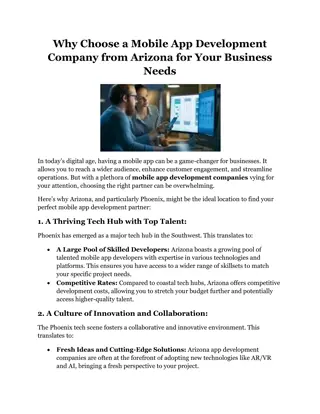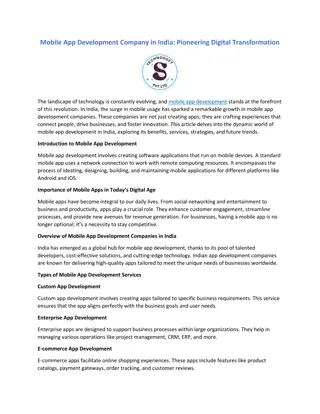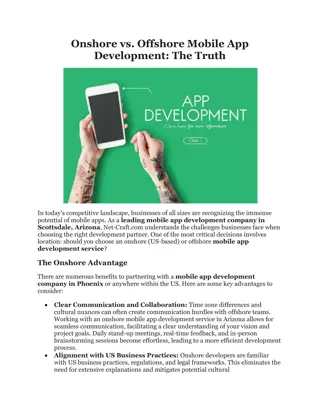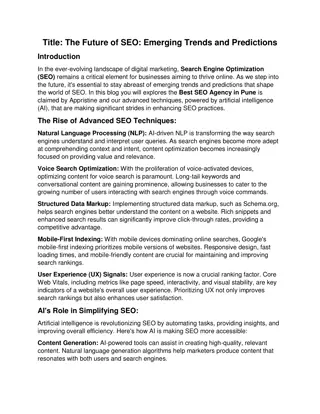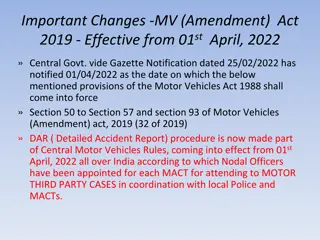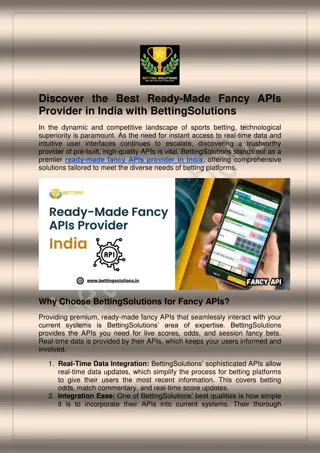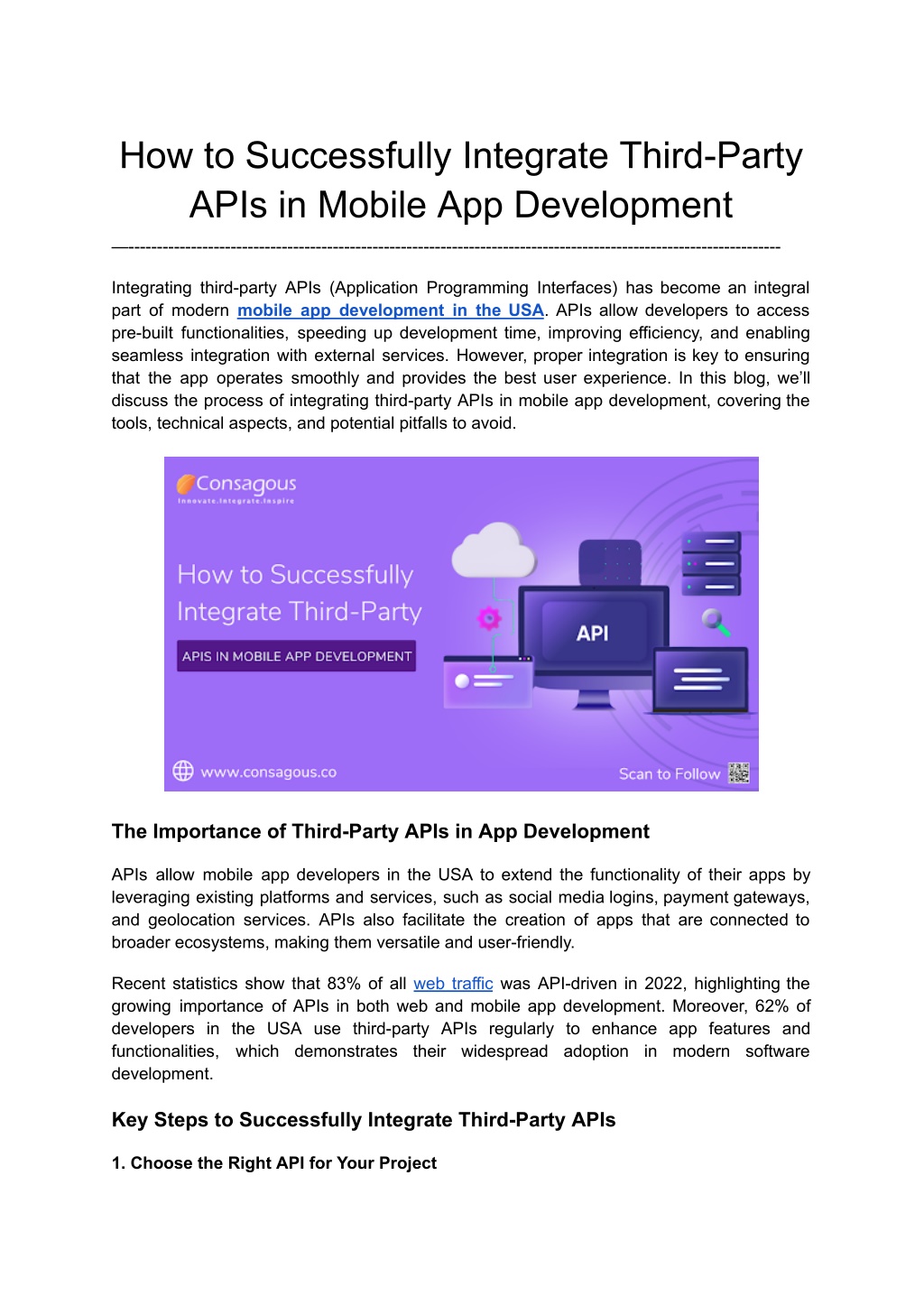
How to Successfully Integrate Third-Party APIs in Mobile App Development
With tools like Postman, Swagger, Redis, and Datadog, developers can streamline the API integration process, making sure their apps are both efficient and reliable.For businesses looking to integrate third-party APIs into their apps, partnering with
Download Presentation

Please find below an Image/Link to download the presentation.
The content on the website is provided AS IS for your information and personal use only. It may not be sold, licensed, or shared on other websites without obtaining consent from the author. Download presentation by click this link. If you encounter any issues during the download, it is possible that the publisher has removed the file from their server.
E N D
Presentation Transcript
How to Successfully Integrate Third-Party APIs in Mobile App Development ------------------------------------------------------------------------------------------------------------------- Integrating third-party APIs (Application Programming Interfaces) has become an integral part of modern mobile app development in the USA. APIs allow developers to access pre-built functionalities, speeding up development time, improving efficiency, and enabling seamless integration with external services. However, proper integration is key to ensuring that the app operates smoothly and provides the best user experience. In this blog, we ll discuss the process of integrating third-party APIs in mobile app development, covering the tools, technical aspects, and potential pitfalls to avoid. The Importance of Third-Party APIs in App Development APIs allow mobile app developers in the USA to extend the functionality of their apps by leveraging existing platforms and services, such as social media logins, payment gateways, and geolocation services. APIs also facilitate the creation of apps that are connected to broader ecosystems, making them versatile and user-friendly. Recent statistics show that 83% of all web traffic was API-driven in 2022, highlighting the growing importance of APIs in both web and mobile app development. Moreover, 62% of developers in the USA use third-party APIs regularly to enhance app features and functionalities, which demonstrates their widespread adoption in modern software development. Key Steps to Successfully Integrate Third-Party APIs 1. Choose the Right API for Your Project
The first step in integrating third-party APIs into your app is selecting the right API for your project. Consider aspects such as the API's reliability, documentation, and developer support. The API should align with your app s objectives and enhance user experience. Tools like Postman and Swagger can be extremely helpful when testing API endpoints and understanding their functionality. These tools allow you to simulate requests and responses, helping to ensure the API works as intended before full integration. 2. Understand API Documentation Before integrating any third-party API, it is crucial to thoroughly understand its documentation. API documentation contains all the necessary details about endpoints, methods, and error handling. Many app development companies in the USA overlook this step, leading to implementation errors. Ensure that the API provider has clear and detailed documentation. Stripe, for instance, provides excellent API documentation for payment processing, making it a preferred choice among developers. 3. Authentication and Authorization Security is a major concern when integrating third-party APIs. Most APIs require authentication, and it s essential to implement secure methods such as OAuth 2.0 or JWT (JSON Web Tokens) to ensure that sensitive data remains protected. OAuth 2.0 is an industry-standard protocol used by many mobile app development companies in the USA to allow secure access to third-party services without exposing credentials. For example, if you're integrating social media logins (e.g., Google, Facebook), OAuth 2.0 ensures user security. 4. Error Handling and Monitoring API integration can sometimes result in errors, such as broken connections, downtime, or rate limits. To mitigate these issues, error handling and monitoring must be prioritised. Tools like Sentry and Datadog are commonly used by top US app development companies to monitor API performance and errors in real-time. Implementing robust error-handling mechanisms will help ensure that your app continues to function even if the API experiences downtime or latency issues. 5. Optimize API Calls Optimizing API calls is vital to ensuring your app s performance and efficiency. Poorly optimized API integrations can lead to slow app performance and high data consumption. Techniques like caching and pagination can improve API call performance, reducing the app s load times and improving user experience. Many mobile app development agencies use tools like Redis for caching and GraphQL to optimize API data fetching. This results in fewer network requests and faster response times, enhancing overall app performance.
Common Challenges in API Integration Even though APIs make mobile app development easier, there are common challenges that developers face: 1. Inconsistent API Updates: APIs are updated frequently, and keeping up with these changes can be time-consuming for developers. If an API provider deprecates certain features, it can break your app's functionality unless immediate updates are implemented. 2. Rate Limits: APIs often impose rate limits, restricting the number of API calls that can be made within a certain period. Developers need to manage these rate limits to avoid service disruptions. 3. Latency Issues: External APIs can introduce latency into your app, which can degrade the user experience. It s essential to monitor API response times and implement fallback strategies if the API fails or responds slowly. 4. Security Concerns: As APIs interact with external services, they can be a potential security vulnerability. Developers need to ensure that all API communications are encrypted using HTTPS, and sensitive data is handled securely. Best Practices for API Integration in Mobile Apps 1. Use Versioned APIs: Always opt for APIs that provide version control. This will ensure that future updates or changes to the API do not disrupt your app s functionality. Many API providers, such as Twilio and Google Maps, offer versioned APIs for better stability. 2. Limit Data Fetching: Minimize the amount of data fetched through the API to prevent performance issues. Only request the data that is necessary for your app's current functionality. 3. Test Thoroughly: Always perform extensive testing when integrating a third-party API into your mobile app. Utilize testing tools like Postman and New Relic to simulate various user scenarios and monitor the API's response. 4. Monitor API Performance: Set up performance monitoring to track how the API is functioning over time. This can help detect issues such as slow response times, downtime, or excessive error rates. Monitoring tools like Sentry or Datadog are essential for this task. Conclusion: APIs as Catalysts for Innovation Third-party APIs are crucial for modern mobile app development, enabling developers to quickly implement complex functionalities and create more dynamic user experiences. By
following best practices such as optimizing API calls, monitoring performance, and ensuring secure authentication, app development companies in the USA can build powerful, API-integrated apps that meet the needs of today s tech-savvy users. With tools like Postman, Swagger, Redis, and Datadog, developers can streamline the API integration process, making sure their apps are both efficient and reliable. For businesses looking to integrate third-party APIs into their apps, partnering with a top-tier mobile app development company in the United States is essential. At Consagous Technologies, we specialize in API integration, ensuring that your app remains robust, secure, and scalable. Contact us today at inquiry@consagous.co, +91 75660 91454, or +1 (213) 257-8054 to learn how we can help you achieve seamless third-party API integration. Original Source: https://bit.ly/48j0MzT





